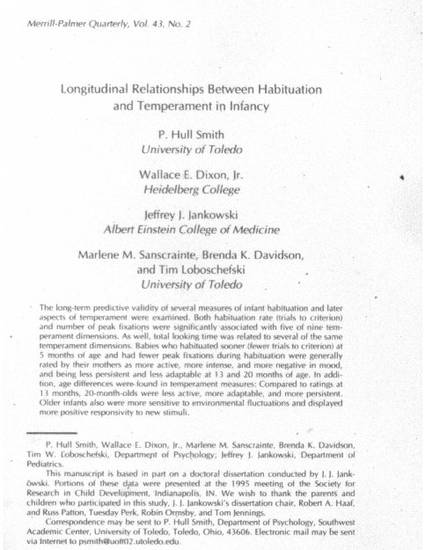
Article
Longitudinal Relationships Between Habituation and Temperament in Infancy
Merrill-Palmer Quarterly
(1997)
Abstract
The long-term predictive validity of several measures of infant habituation and later aspects of temperament were examined. Both habituation rate (trials to criterion) and number of peak fixations were significantly associated with five of nine temperament dimensions. As well, total looking time was related to several of the same temperament dimensions. Babies who habituated sooner (fewer trials to criterion) at 5 months of age and had fewer peak fixations during habituation were generally rated by their mothers as more active, more intense, and more negative in mood, and being less persistent and less adaptable at 13 and 20 months of age. In addition, age differences were found in temperament measures: Compared to ratings at 13 months, 20-month-olds were less active, more adaptable, and more persistent. Older infants also were more sensitive to environmental fluctuations and displayed more positive responsivity to new stimuli.
Keywords
- Longitudinal,
- Relationships,
- Habituation,
- Temperament,
- Infancy,
- Infants,
- Cognition,
- Language development,
- Child development,
- Distractibility,
- Mental stimulation
Disciplines
Publication Date
April, 1997
Publisher Statement
A PDF of the final version of an article may be deposited by authors on their personal website, institutional repository, or not-for-profit server 12 months after publication. This document was originally published in Merrill-Palmer Quarterly.
Citation Information
Wallace E. Dixon Jr., P H Smith, Jeffrey J Jankowski, Marlene M Sanscrainte, et al.. "Longitudinal Relationships Between Habituation and Temperament in Infancy" Merrill-Palmer Quarterly Vol. 43 (1997) p. 291 - 304 ISSN: 0272-930X Available at: http://works.bepress.com/wallace-dixon/15/
